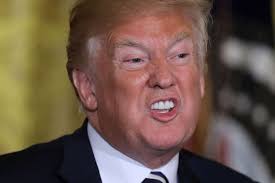(A version of this article was posted on this site on June 4, 2016.)
Trump’s vicious vendettas against all of his critics are part of his sociopathic pathology. Even worse, it goes back for decades.
His public humiliations of the government officials who testified against him in the recent impeachment trials are just part of a long history of how Trump works to eliminate critics who have the facts to counter his fantasy stories about being a great leader, businessman, family man, and delusional intellect.
This means Trump’s vindictiveness and pettiness should be well-known to the American public by now.
While Trump’s attacks on those who testified against him in his impeachment trial are well-known, it’s worth remembering some earlier events that were all prelude to his current attacks on his critics. This is a history of behavior that will be with him until he dies. It’s part of his pathology, threatening to carry the nation down with him.
For instance, around 2017, Trump criticized Judge Gonzalo Curiel, who presided over one of the cases against Trump University and ordered the release of documents related to that case. In this instance, Trump accused the judge of being prejudiced against him because he is of Mexican descent, even though the judge was born in Indiana.
Trump’s recent attacks on a Federal judge who ruled against this interest in Trump University are not new. Such attacks are part of Trump’s personality and his way of doing business. He does not cope well when things don’t go his way.
Just ask former securities analyst Marvin Roffman, who, in April 1990, worked at the Philadelphia securities firm of Janney Montgomery Scott. When Roffman was quoted in a Wall Street Journal interview as saying that bondholders should sell junk bonds issued on Trump’s newly opened Taj Mahal Casino in Atlantic City, New Jersey, Trump went ballistic and decided to go for blood.
As Jonathan Laing reports in this complete Barron’s article, Roffman said the $675 million in junk bonds, issued at 14%, were not sufficiently secured by casino revenues to pay the interest. The Trump organization then said the casino would be “The Eighth Wonder of the World.”
The “people I don’t take too seriously are the critics—except when they stand in the way of my projects.”
Donald Trump
The Art of the Deal (1987)
Barron’s said Trump’s inflated name and reputation pushed the bond price to 101 cents on the dollar, but reality soon set in, and the bond price fell to about 80 by 1990-1991 and soon to 20 cents on the dollar as casino revenues failed to materialize.
I covered this story as the  editor for Zacks Investment Research in Chicago. The story developed at the same time that more investment firms were questioning the quality and motives of equity analysts who wrote research reports on some companies.
editor for Zacks Investment Research in Chicago. The story developed at the same time that more investment firms were questioning the quality and motives of equity analysts who wrote research reports on some companies.
While there has been research produced by brokerage firms who sell stocks (called “sell-side” research) and other research produced by buyers of brokerage and banking services (called “buy-side”), an increasing number of buy-side institutions began setting up separate, independent research divisions to produce their company research for in-house use only.
This alternate setup was designed to reduce or eliminate the conflicts of interest between the investment bankers and their own equity and bond research analysts.
Roffman was an independent analyst in the truest sense. He conducted his own research and analysis and reported his conclusions. Trump came from a different world.
As cited by Laing and Alan Abelson, who wrote about this Trump-Roffman episode for Barron’s, Trump went ballistic when Roffman warned investors about the danger of junk bonds. To punish Roffman, Trump called the CEO of Janney Montgomery, made some false and disparaging personal remarks about Roffman (sound familiar?), and threatened to sue the firm unless Roffman wrote a public apology.

Under pressure, Roffman agreed. However, Trump then wanted him to change a sentence in the letter saying the bonds were a viable investment. After consulting with his lawyer, Roffman retracted the apology letter as described in Laing’s Barron’s article. Janney then proceeded to fire Roffman a few days after the Wall Street Journal article appeared. So much for the corporate backing of independent research analysts on Wall Street.
The story ends this way: Trump never sued Janney. Taj defaulted on its first interest payment in October 1990, forcing Taj junk bond prices into the 20s. As predicted, Taj filed for Chapter 11 bankruptcy in the spring of 1991. Big money interests again victimized Atlantic City.
As for the people involved, Roffman exited his 30-year career as an equity analyst and became a successful money manager. He also won a $750,000 arbitration case against Janney, and he settled with Trump for an undisclosed amount that remains secret due to a confidentiality agreement. In a later Politico article, Roffman said: “I’m telling you, Trump is a brutal guy.” And that was in 1990.
Trump’s unethical and near-criminal behavior was honed in Manhattan’s sophisticated world. Its media, law, business, investment, and society worlds all knew Trump’s objective, pathetic story. Yet, they benefitted from his excesses and seemed to have enjoyed his company as long as he paid the bills. Trump is a product of a decadent Manhattan culture.
Today, Trump is still up to his old Manhattan tricks at the national level. Maybe he can “Make America Great Again,” just like he made the Taj Mahal Casino in Atlantic City into “the Eighth Wonder of the World.”











